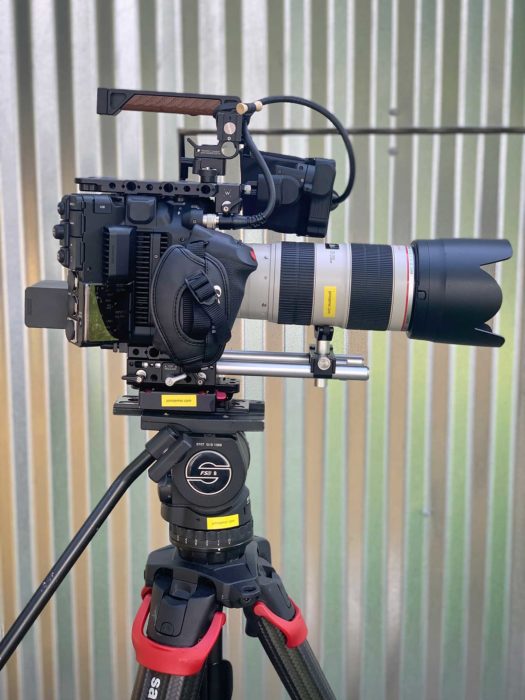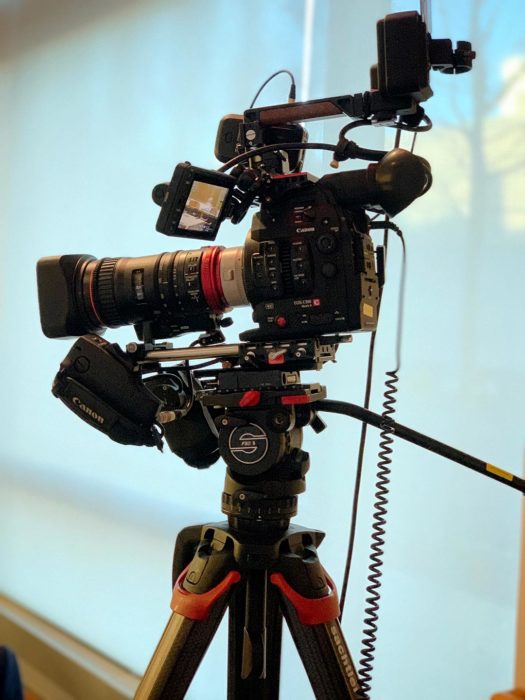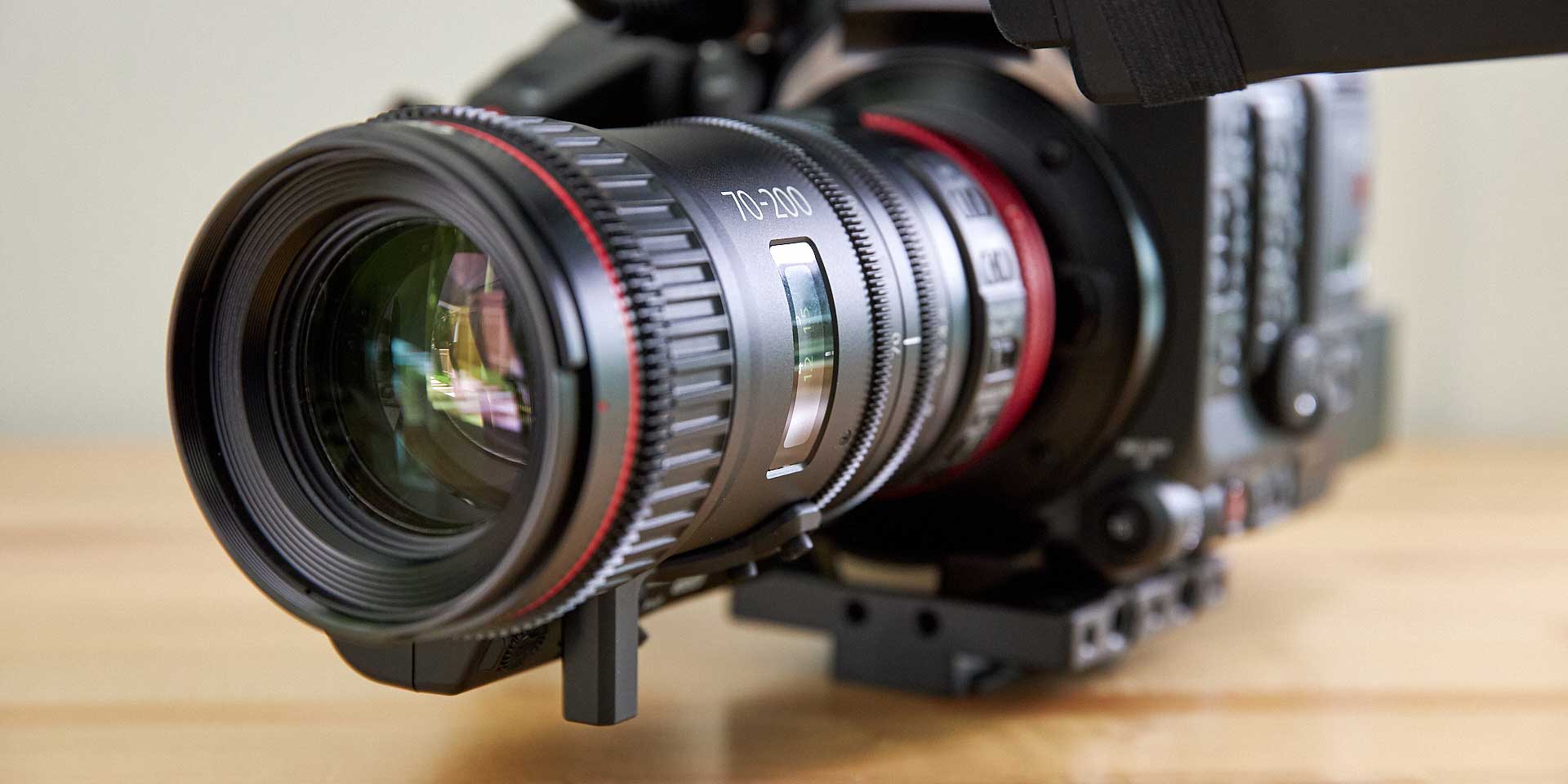This test is long overdue – a look at the focus breathing on the Canon CN-E 70-200mm T4.4 Compact-Servo zoom. So long, in fact, the lens I am comparing it against, the Canon EF 70-200mm f/2.8L IS USM II, was replaced by Canon with a Mark III version in 2018.
Why now?

I have been testing the new Canon C500 Mark II camera and I had my CN-E 70-200mm out along with my EF 70-200mm to test the camera’s full-frame vs. Super35 modes so it seemed as good a time as any to finally test for myself how the CN-E’s focus breathing stacked up against the EF’s. I had done the same test back in 2018 comparing a sister lens, the CN-E 18-80mm T4.4, against EF glass in the same focal range.
Why this test?
The CN-E 70-200mm T4.4 Compact-Servo zoom is a hybrid cinema lens. The servo provides motorized zoom capability built into the lens, through an included handgrip with a rocker switch, or by custom assigning a joystick on the camera. The lens is parfocal, it has a declicked aperture ring, built-in gears for manual follow-focus and zoom control, three levels of optical image stabilization; excellent sharpness, micro-contrast, and clarity; and it is color matched to the rest of Canon’s Cinema EOS lens line.
What makes it a hybrid cinema lens is that it has autofocus. Most cinema glass is manual focus. This is a huge benefit to users of Canon’s Dual-Pixel Autofocus (DPAF). The only negative to come with autofocus is that lens does not have hard stops like on a regular cinema lens. This makes it difficult to consistently hit focus marks manually which one might need when using a follow-focus.
There is another plus to the CN-E lens and that is that its focus ring is very nicely dampened. It is a big improvement over EF autofocus glass and specifically the EF 70-200’s focus ring which tends to be harder to control and to finesse.

The EF 70-200mm f/2.8L IS USM II lens is designed for still image capture. Like the CN-E lens it is autofocus with manual override and it has a few levels of image stabilization. Its zoom ring is stiffer than the one on the CN-E lens making it pretty much impossible to zoom smoothly while filming. It is also not parfocal so changing the focal length while filming can lead to out of focus end points.

Some may point out that the CN-E is Super35 and the EF lens full-frame but it turns out that the CN-E lens easily covers full-frame.
The reason to compare the CN-E and EF versions of these lenses is because many users often wonder if the $4,600 CN-E glass is worth it over the $1800 EF lens. It’s a big price difference and the EF version is a great optical performer in its own right. It’s also a stop faster.
While there are many aspects of cinema lens design to consider, some mentioned above and some to follow, focus breathing is one data point in that comparison.
Focus breathing, AKA lens breathing, is the apparent change in image size within a frame as one racks focus on a lens from near to far and vice versa. It is a moot point on stills lenses which are designed to capture only one frame of an image but it can be an issue on a lens used to capture motion. In that case focus breathing may become a visual distraction and call too much attention to itself.
The Test
Here is the focus breathing test in the Canon CN-E 70-200mm T4.4 Compact-Servo lens versus the Canon EF 70-200mm f/2.8L IS USM II lens:
Focus Breathing: Canon CN-E Compact-Servo 70-200mm T4.4 & EF 70-200mm f/2.8L IS USM II on YouTube and Vimeo.
In the video we can see that the Canon CN-E 70-200mm T4.4 Compact-Servo Cinema Lens does have focus breathing and it is roughly the same as seen in Canon’s EF 70-200mm f/2.8L IS USM II zoom lens.
That is a bit of a disappointment. The CN-E 70-200mm’s sister lens, the CN-E 18-80mm T4.4 has virtually no focus breathing for much of its range. But as I explain in the video and as I mention above the CN-E 70-200mm T4.4 still has many advantages over a lens designed for still photography.

In my extensive review of the CN-E 18-80mm T4.4 Compact-Servo lens I go into what makes that lens unique along with its applications for camera operators especially ones working as a one-man band. Those same features and that ease of use I found with the CN-E 18-80mm T4.4 also applies to the 70-200mm version. They include many of the characteristics mentioned earlier (parfocal, servo action, declicked aperture, better dampened focus throw, greater clarity, etc) So, while the CN-E 70-200mm T4.4 Compact-Servo lens has some focus breathing it still remains a uniquely capable performer and a lens extremely well suited to video production.
Three more points to consider:

- The CN-E lens line, being cinema glass, has its focus and zoom markings oriented to the side of the lens barrel (see first image up top and below). This makes them far easier to read and access while working. EF lenses designed for still photography have their focus and zoom markings along the top of the lens barrel, a configuration which works better for still photography where one is more likely to be seeing over the top of the camera.
- While the CN-E 70-200mm is a T4.4 lens and the EF 70-200mm is an f/2.8 lens they are in actuality within a stop or less of each other in light gathering. The T4.4 of the CN-E lens is equivalent to f/4.0 and it is very consistent throughout its zoom range. The f/2.8 of the EF zoom is subject to the optical characteristics of that lens (e.g. vignetting of varying width and strength by focal length) and to the normal variance one sees with f-stop ratings. F-stops are mathematical values arrived at through a formula where T-stops are measured values.
- The IS, image stabilization, on the CN-E lenses is optimized for video leading to much smoother IS implementation. The IS on the most EF lenses including the EF 70-200mm f/2.8L IS USM lens is optimized for still photography. When used for video it works but it tends to get jittery if the camera is moved too quickly while filming.

